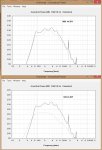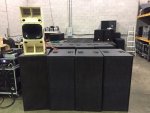Re: 60 Degree DIY Mid Hi
There are quite a few people who simply believe that a clipped signal will burn a speaker easier than a sine wave . WITHOUT paying any attention to the actual voltage (and the resultant wattage-area under the curve).
Of curse with signals of the same peak voltage-but they ignore that part and just focus on the "clipped signals cause more damage" part.
I would be VERY CAREFUL with that statement.This is the reason why clipping an amp will burn up drivers more than an unclipped amp. The voltage is no greater when clipped, there is just more average power delivered, and the harder the amp is clipped the closer it comes to delivering twice as much (+3dB) more average power than it's sine wave rating would indicate.
There are quite a few people who simply believe that a clipped signal will burn a speaker easier than a sine wave . WITHOUT paying any attention to the actual voltage (and the resultant wattage-area under the curve).
Of curse with signals of the same peak voltage-but they ignore that part and just focus on the "clipped signals cause more damage" part.


